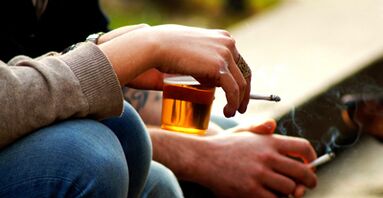According to many experts, chronic prostatitis is an inflammatory disease, the cause of which is an infection with a possible adhesion of autoimmune disorders, characterized by damage to the parenchymal and interstitial tissue of the organ.The disease has known medicine since 1850, but today it remains insufficiently studied and poorly treatable.Chronic bacterial (6-10%) and non-bacterial (80 - 90%) prostatitis are the most common and socially significant inflammatory diseases in men that significantly reduce their quality of life.The disease is registered mainly in young and middle-aged people and is often complicated by impairment of copulation and generative functions (reduction of potency, infertility, etc.).The disease is recorded in men in 8-35% of cases aged 20 to 40.
The cause of bacterial prostatitis is a pyogenic flora that penetrates iron from the urethra, or lymphogenic and hematogenous pathways.The etiology of chronic non-bacterial prostatitis and its pathogenesis remain unknown.They are mostly suffered by men over the age of 50.
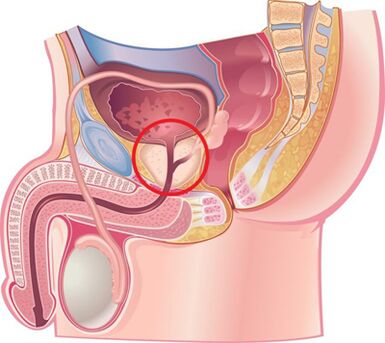
The causes of the development of the disease
Chronic prostatitis is currently considered a polyethene disease.There is an opinion that the disease occurs as a result of the penetration of the infection into the prostate, and then the pathological process proceeds without its participation.This is facilitated by a number of non-infectious factors.
Infectious factors in the development of chronic prostatitis
In 90% of cases, pathogenic agents enter the gland from the urethra, causing acute or chronic prostatitis.There have been cases of asymptomatic transport.The course of the disease is influenced by the state of the defenses of the human body and by the biological properties of the pathogen.It is assumed that the transition from acute prostatitis to the chronic one takes place due to the loss of elasticity of the tissues due to the excessive production of fibrous tissue.
Among the causal agents of chronic prostatitis there are the following pathogens:
- In 90% of cases, the disease reveals gram -negative bacteria such as Escherichia coli (Escherichia coli), Enterococcus faecalis (faecal entertainment) and a little less frequently - Pseudomonas Aeruginosa, Klebsiella Spp., Proteus spp., Pseudomonas Aeruginosa, Enterabacter Aerogenes and Acinetobacterspp.Gram-positive bacteria Enterorococci, Streptococci and Stafilococci are rare.
- The role of negative coagulase staphylococci, ureaplasma, clamidia, Trichomonas, Gardnerella, anaerobic bacteria and mushrooms of the candid genre has not been completely clarified.
The infection enters the prostate in different ways:
- The ascending way is the most likely, as highlighted by the frequent combination of prostatitis and urethritis.
- Hematogenic prostatitis develops when the infection penetrates the gland through blood flow, which is observed in chronic tonsillitis, sinusitis, periodontitis, pneumonia, cholecystitis and cholangitis, in diseases of purulent skin, etc.
- Contacted chronic prostatitis develops with urethritis and restrictions of the urethra, when the infection penetrates the gland that rises with the flow of urine, with purulent infections of the kidneys, canalicular from epipiditides, defentiment and funiculitis, during urological diagnostics and therapeutics (catheterization, bumping, urethral instructions), including defentitis andfuniculitis.
- The infection lymphogenically penetrates the prostate with proctots, thrombophlebitis of the hemorrhoidal veins, etc.

Non -infectious factors in the development of chronic prostatitis
Chemical factors
According to experts, the main role in the development of chronic prostatitis belongs to the urine of intake reflux when the urine launches from urethra to iron, which leads to a violation of the emptying of the prostate and seminal vesicles.
With the disease, vascular reactions develop to edema of the organ, nervous and humoral regulation of the tone of the smooth muscle tissues of the urethra and alpha activation are disturbed1–Urenoreceptors cause the development of dynamic obstruction and contributes to the development of new intraprostatic reflux.
The urals contained in the urine, with reflux, lead to the development of an "chemical inflammatory response".
Hemodynamic disorders
Support chronic inflammation of circulatory disorders in the pelvic organs and scrotum.Stagnation develops in people who lead a sedentary lifestyle, for example, for drivers, office workers, etc., with obesity, sexual withdrawal, sexual sexual dysmetria, frequent hypothermia, mental and physical overloads.Maintain the inflammatory process, take spicy and spicy foods, alcohol and smoking, etc.
Other factors
There are many other factors that support the chronic inflammatory process in the prostate.These include:
- Hormonal.
- Biochemical.
- Violations of the immune response.
- Autoimmune mechanisms.
- Infectious and allergic processes.
- Features of the structure of the prostate glands, leading to difficulty in full drainage.
Quite often, it is not possible to establish the causes of chronic prostatitis.
Classification of prostatitis
According to the classification proposed in 1995 by the United States National Institute of Health, prostatitis is divided into:
- Sharp (Category I).It's 5-10%.
- Chronic bacterial (category II).It is 6 - 10%.
- Chronic non -kissing inflammatory (Category IIIA).It is 80 - 90%.
- Non -basic pelvic pelvic pain syndrome non -bacterial.
- Chronic prostatitis detected by chance (category IV).
Signs and symptoms of chronic prostatitis
The course of chronic prostatitis is long, but not monotonous.The periods of exacerbation are followed by periods of relative calm, which occur after a complex anti -inflammatory and antibacterial therapy.
The development of chronic bacterial prostatitis is often preceded by bacterial urethritis or gonorrhea, non -bacterial circulatory disorders in the pelvic and scrotal organs (hemorrhoids, varicocell, etc.), sexual excesses.
Patients with chronic prostatitis present many complaints.They have been going to doctors for years, but very rarely are they examined for prostate disease.About a quarter of patients present no disorder or the disease manifests itself with few clinical symptoms.
Complaints of patients with chronic prostatitis can be divided into different groups.
Urinary disorders associated with the narrowing of the urethra:
- Initially difficulty urinating.
- Weak flow of urine.
- Intermittent or dripping urination.
- Feeling of incomplete emptying of the bladder.
Symptoms caused by the irritation of nerve endings:
- Frequent urination.
- The need to urinate is acute and strong.
- Urination in small portions.
- Urinary incontinence during the urge to urinate.
Pain syndrome:
- The intensity and nature of the pain are different.
- Pain Location: lower abdomen, perineum area, rectum, groin and low part of the back, the internal surface of the hips.
Sexual function disorders:
- Pain in the rectum and urethra during ejaculation.
- Slow erection.
- Loss of orgasm.
- Premature ejaculation, etc.
From the nervous system: neurotic disorders in the form of fixing the attention of patients in the state of their health.
Signs and symptoms of chronic nonbacterial prostatitis
Chronic pelvic pain in men (CFTB) proceed with the usual symptoms for chronic prostatitis, but in the third portion of urine and a secret of the prostate in the study of bacteria are absent.Simulating the CTB can simulate chronic nebatteric interstitial cystitis, rectum diseases, spastic myalgia of the Spastic Pelvic Floor and a functional prostate caused by the unclean of altered organic organs and its hemodynamics.
In case of impaired autonomic function, Atony and impaired innervation of the gland are noted, which is manifested by difficulties in rapid and complete closure of the lumen of the urethra.At the same time, urine, after urination, continues to stand out for a long time.In such patients, in the study, instability and increased excitability are found, which is manifested by increased sweating and excitability of cardiac activity, changes in the dermograph.
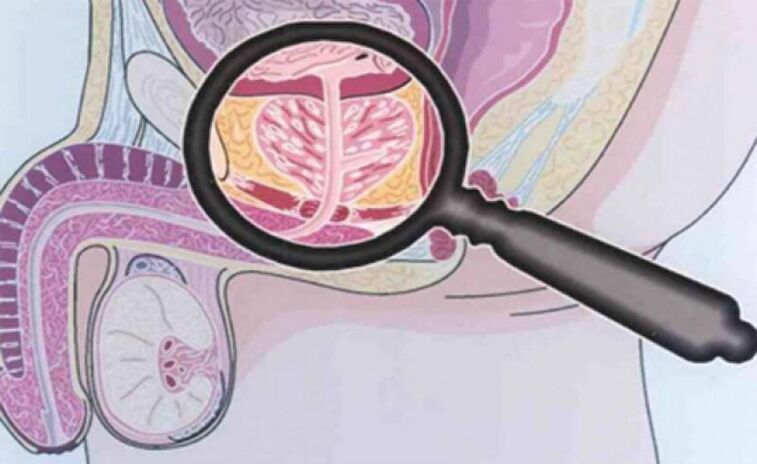
Complications of the disease
The long course of chronic prostatitis is complicated by disorders of sexual and reproductive functions, the development of diseases such as vesiculitis and epipidimitis, as well as sclerosis of the organ.Sclerosis of the organ worsens local microcirculation and urodynamics, as well as the results of surgical interventions.Fibrosis of the perijumitral tissues leads to the development of urination disorders.
Diagnostics
Due to the fact that there are many reasons for the development of chronic prostatitis, a whole complex of diagnostic studies is used to diagnose.The success of the treatment depends on the correct determination of the causes of the disease.The diagnosis of chronic prostatitis is based on the following data:
- Classic triad of symptoms.
- A complex of physical methods (rectal examination of the prostate finger).
- A complex of laboratory methods (urine analysis and microscopy of the prostate, seeding and determination of the sensitivity of microflora to antibacterial drugs, general urine and blood tests).
- To detect gonococci, bacterioscopy is tightened by urethra, PCR and serological methods (to detect ureaplasmes and chlamydia).
- Urofluometry.
- Prostate biopsy.
- A complex of instrumental methods (ultrasound).
- Determination of the patient's immune status.
- Determination of neurological status.
- With the ineffectiveness of treatment and suspicion of the development of complications, calculated and magnetic resonance imaging, blood seeding, etc.
Palpation of the prostate gland
Palpation of the prostate, which increases during the period of exacerbation and decreases in the period of the subsidiary of the inflammatory process, is of fundamental importance in the diagnosis of the disease.In chronic prostatitis, during the period of exacerbation of the iron is swollen and painful.
The density of the body's consistency can be different: the softening and compaction areas are palpate, the areas of the west are determined.On palpation, it is possible to evaluate the shape of the gland, the condition of the tubercles of seeds and the surrounding fabrics.
The process of transrectal finger exams is combined with gland sequestration.Sometimes it is necessary to get a secret from each share separately.
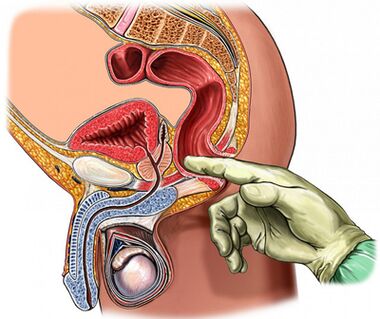
Analysis of 3 glass of urine and secret of the prostate
The gold standard in the diagnosis of chronic prostatitis is:
- Collection of the first portion of urine.
- Collection of a second portion of urine.
- Get the secret of the massage gland.
- Collection of third portion of urine.
Subsequently, a microscopic and bacteriological examination of the material is carried out.
With inflammation of the prostate:
- The microbial count (CFU) exceeds 103/ml (104/ml for epidermal staphylococci), but we must not neglect the small number of microbes, which number in the dozens and hundreds.
- The presence of 10-15 leukocytes in the field of view, identified under a microscope, is a generally accepted criterion for the presence of an inflammatory process.
Prostate secretion and the 3rd portion of urine are subjected to microscopic and bacteriological examination:
- In chronic bacterial prostatitis, an increase in the number of leukocytes is observed in the secretion of the gland and in the third portion of post-massage urine and bacteria (mainly of the intestinal group) are released.
- With non-bacterial prostatitis, an increase in the number of leukocytes in the secretion of the gland is observed, but the microflora is not detected.
- In the CPPS there is also no increase in the number of leukocytes and microflora.
Normal prostatic secretion:
- Less than 10 leukocytes per field of view.
- There is a large amount of lecithin granules.
- There is no microflora.
In chronic prostatitis, the following are found in prostatic secretion:
- The number of leukocytes is high: it exceeds 10-15 in the visual field.
- The number of lecithin granules is reduced.
- The pH of the secretion shifts towards the alkaline side.
- The acid phosphatase content is reduced.
- Lysozyme activity is increased.
Obtain negative results of prostate secretion once it does not demonstrate the absence of an inflammatory process.
The value of the prostatic secretion crystallization test remains.Normally, during crystallization, a characteristic fern leaf-shaped pattern is formed.In case of violation of the aggregation properties of prostatic secretion, a similar pattern is not formed, which occurs when the androgen hormonal background changes.
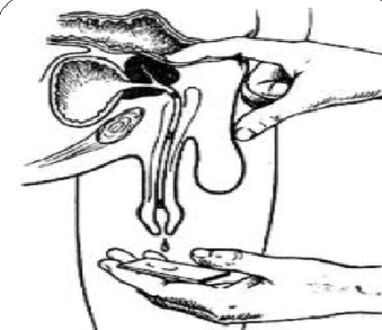
Ultrasound study
In case of suspicion of prostate illness, an ultrasound examination of the gland itself is used (ultrasound transal), the kidneys and the bladder are optimal, which allows you to determine:
- Volume and size of the gland.
- The presence of calculations.
- The size of the seed bubbles.
- The condition of the walls of the bladder.
- The amount of residual urine.
- Clothing structures.
- Another type of pathology.
Other prostate research methods
- The state of urodynamics (study of urine flow rate) is easily and simply determined using a study such as uroflowetry.With the help of this study, it is possible to timely detect signs of infravital obstruction and perform dynamic observation.
- Puncture biopsy is carried out in case of suspicion of abscess, benign hyperplasia and prostate cancer.
- In order to clarify the causes of the development of infravezicular obstruction, a radiological and endoscopic examination is carried out.
- With a long-flow inflammatory process, it is recommended to perform urethrocystoscopy.
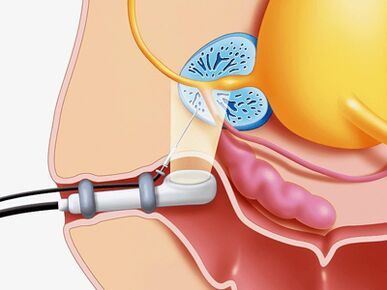
Differential diagnosis
Chronic prostatitis must be distinguished by vesoloprostatostasi, prostative prostatopathy, congestive prostatitis, myalgia of the pelvic floor, neuropsychiatric disorders, pseudadissinergia, reflected sympathetic dystrophy, inflammatory diseases of other organs: interstitial cystitis, osteitis of pubic symphysis, sexual dysfunction, hypertrophy of the bladder,Urethral stenosis, tuberculosis, prostate and bladder cancer, urolithiasis, chronic epipidimitis, inguinal hernia.
Treatment of chronic prostatitis
Treatment of chronic prostatitis should begin with changes in the patient's lifestyle and diet.
In the treatment of the disease, drugs that affect different parts of the pathogenesis are used simultaneously.
Main directions of therapy:
- Elimination of cause microorganisms.
- Anti -inflammatory therapy.
- Normalization of blood circulation in the prostate and in the pelvic organs.
- Normalization of adequate drainage of the prostatic acini.
- Normalization of the hormonal profile.
- Prevention of organ sclerosis.
For the treatment of chronic prostatitis the following groups of drugs are used:
- Antibacterial.
- Anticholinergic.
- Vasodilators.
- Alpha1- Adrenergic blockers.
- 5ALFA REDUTTASI inhibitors.
- Cytokine inhibitors.
- Anti -non -seroidal inflammatory.
- Angioprotectors.
- Immunomodulators.
- Preparations affecting urate exchange.
Antibiotics in the treatment of chronic bacterial prostatitis
Antibacterial therapy should be carried out taking into account the sensitivity of the detected microorganisms to antibiotics.In the case of non-detection of the pathogen, an empirical antimicrobial treatment is used.
The drugs of choice are fluoroquinolones of generation II - IV.They quickly penetrate the tissues of the gland with ordinary methods of use, show activity against a large group of Gram-negative microorganisms, as well as ureaplasma and chlamydia.In case of failure of antimicrobial treatment, you should take:
- Microflora polyurezancy,
- Short treatment courses (less than 4 weeks),
- Incorrect selection of the antibiotic and its dosage,
- changes in the type of pathogen,
- The presence of bacteria living in the ducts of the prostate, covered by a protective extracellular membrane.
The duration of the treatment should be at least 4 weeks with subsequent mandatory bacteriological control.In the event of conservation in the third portion of urine and secret of the prostate of bacteriuria more than 103Corresponding re-antibacterial therapy is prescribed for a period of 2 to 4 weeks.
Cytokine inhibitors in the treatment of chronic prostatitis
Cytokines are glycoproteins secreted by immune cells and other cells during inflammatory and immune response conditions.They take an active part in the development of the chronic inflammatory process.
Non -steroid anti -inflammatory drugs
Nonsteroidal anti-inflammatory drugs have an anti-inflammatory effect and reduce pain and fever.Widely used in the treatment of chronic prostatitis in the form of tablets and suppositories.The most effective route of administration is the rectal route.
Immunotherapy
In the treatment of chronic bacterial prostatitis, in addition to antibiotics and anti -inflammatory drugs, immunomodulatory agents are used.The most effective is the road to rectal administration.An immunomodator is widely used, increasing the functional activity of phagocytes, which contributes to a more effective elimination of pathogens.
Alpha-blockers in the treatment of chronic prostatitis
It has been established that alpha-1 adrenergic blockers normalize the tone of the smooth muscles of the prostatic urethra, seminal vesicles and prostatic capsule, which makes drugs of this group very effective in treating the disease.Alpha-1 adrenergic blockers are used in patients with severe urination disorders in the absence of an active inflammatory process.
For CPPS, the treatment period ranges from 1 to 6 months.
5A Redittasi inhibitor in the treatment of abotteric prostatitis and ktbb
It has been established that under the influence of the enzyme 5A reductase, testosterone transforms into a prostatic form 5A-diidotrotestosterone, the activity in prostate cells is more than 5 times higher than the activity of testosterone itself, which in older adults leads to an increase in the organ due to epithelial organization and stromal components.
When taking a 5A reductase inhibitor for 3 months, atrophy of the stromal tissue is observed, for 6 months - glablandular, the secretory function is inhibited, the severity of pain and the volume of the gland is reduced, tension and edema of the organ decrease.
The role of anti-sclerotic drugs in the treatment of chronic prostatitis
With long-lasting inflammation in the prostate gland, fibrosis develops, which is manifested by disorders of microcirculation and urodynamics.In order to prevent the fibrification process, anti-sclerotic drugs are used.
Other drugs used in the treatment of chronic prostatitis
Along with the above drugs, the disease is used to treat the disease:
- Antistamine.
- Vasodilators and angioprotectors.
- Immunosuppressants.
- Preparations affecting the exchange of urate and trinatrium salt of citric acid.
Vegetable products
Effective in the treatment of prostatitis is the use of a drug in the form of suppositories containing a complex of biologically active peptides isolated from the prostate gland of cattle.
Under the influence of the drug occurs:
- Stimulation of metabolic processes in glandular tissues.
- Improve microcirculation.
- Reduces swelling, leukocyte infiltration, stagnation of secretions and pain.
- Prevention of the formation of trombers in the prostate venules.
- Increased activity of the secretory epithelium of the acini.
- Improve sexual function (increase in libido, restoration of erectile function and normalization of spermatogenesis).
Finger massage of the prostate gland
Numerous researchers argue that with chronic prostatitis you should use massage with fingers, taking into account the contraindications known.
Physiotherapy
The effectiveness of the physiotherapy procedures in the treatment of prostatitis today has not been demonstrated, the mechanism of action has not been scientifically established and the adverse reactions have not been studied.
Chronic prostatitis prevention
When starting to prevent the development of chronic prostatitis, you should know:
- The risk of developing the disease increases with age.
- The representatives of the Negroid race are more predisposed to the disease.
- A family predisposition to the disease cannot be excluded.
People predisposed to the development of chronic prostatitis should be more attentive to their health.
Tips for disease prevention:
- Take a sufficient amount of liquid.Frequent urination promotes the leasing of the microflora from the urethra.
- Prevent diarrhea and constipation.
- Adhere to a rational diet.Do not eat food saturated with carbohydrates and saturated fats, which leads to an increase in body weight.
- It should be limited to the use of substances that irritate the urethra: sharp and spicy dishes, smoked meats, sauces and seasonings, coffee and alcohol.
- Refuse smoking.Nicotine negatively affects the condition of the vascular walls.
- Not excessive.
- Do not keep emptying your bladder.
- Guide an active lifestyle, do sports.Do the exercises to strengthen the pelvis muscles, which allows you to eliminate the stagnation of venous blood, which, in turn, supports the normal function of the prostate gland.
- Lead regular sex life.Avoid prolonged abstinence.Iron should be freed promptly by the secret.
- Remains adhering to monogame relationships.Illegal sexual relationships increase the probability of acquiring sexual transmission diseases.
- If complaints appear from the genitourinary authorities, contact a urologist immediately.
